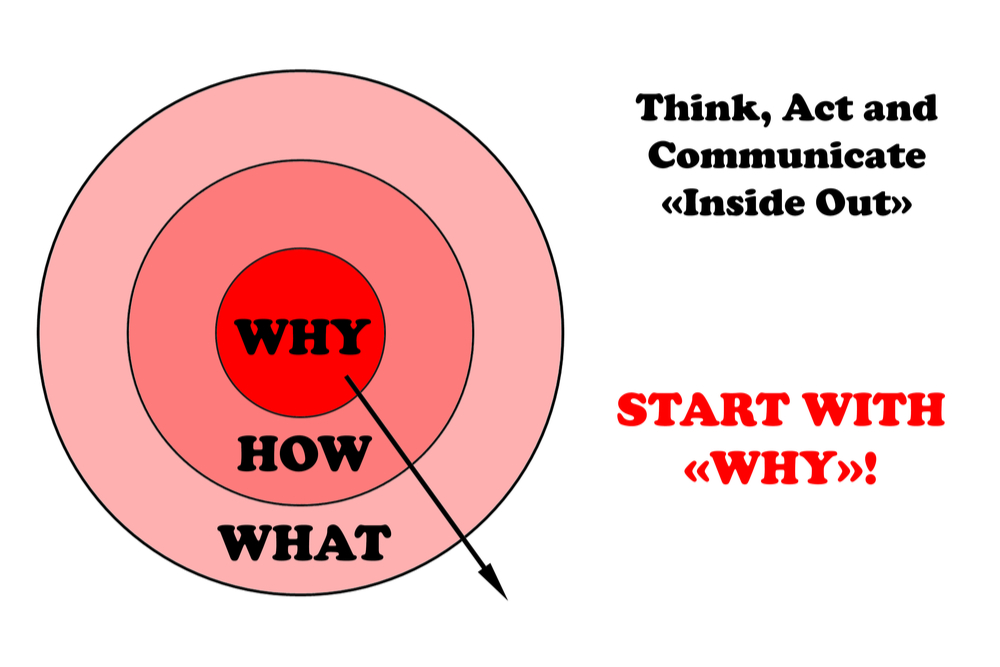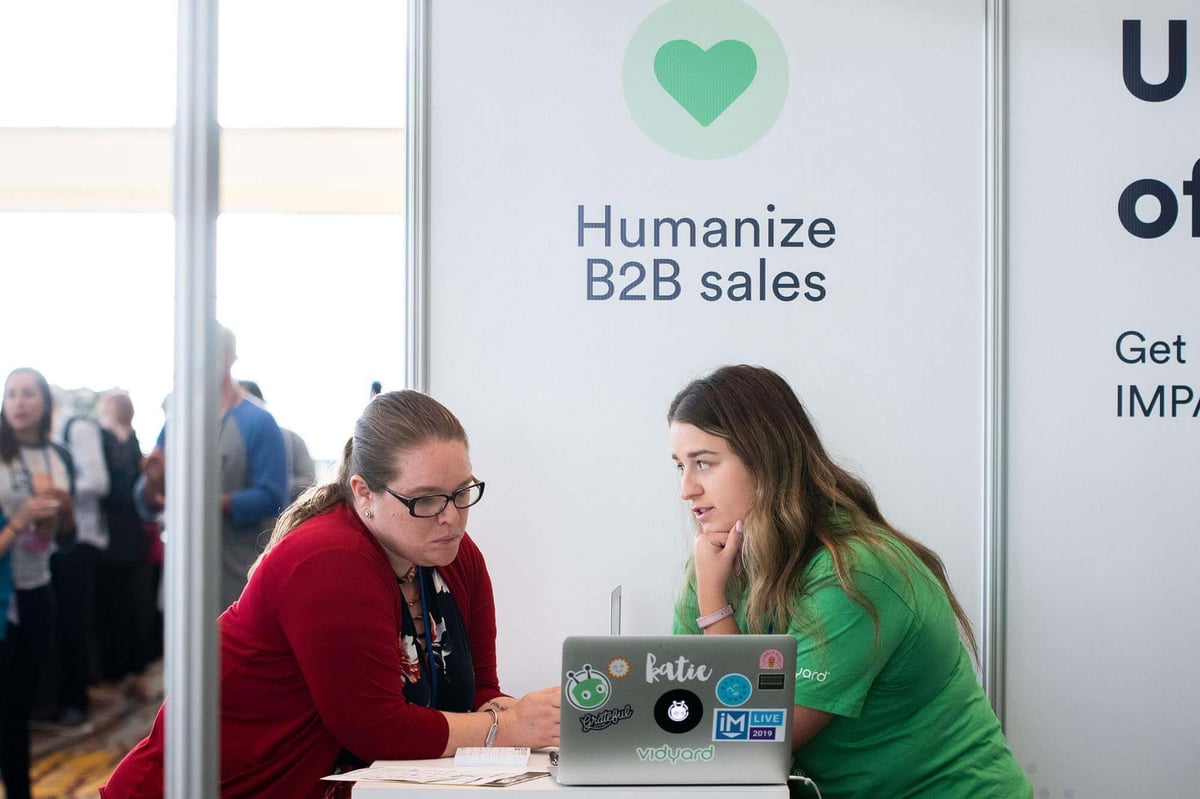Join 40,000+ sales and marketing pros who receive our weekly newsletter.
Get the most relevant, actionable digital sales and marketing insights you need to make smarter decisions faster... all in under five minutes.
Simon Sinek's 2009 TED Talk turns 10 years old this month. During the past decade, starting with why has changed the status quo of marketing, reframing the way that businesses position themselves.
Sinek asserted that people don't buy what you do, but why you do it. Sinek explains the principle using Apple, Martin Luther King Jr., and the Wright Brothers as examples. Each had a strong sense of the "why" behind their efforts.
Starting with why results in audiences identifying with your purpose and brand identity.
Apple, for example, could say, “We make great computers. They are beautifully designed, simple-to-use, and user-friendly.”
Instead, Apple changes the conversation to something like this: “In everything we do, we believe in thinking differently. The way we challenge the status quo is by making beautifully-designed products that are simple to use and user-friendly — and we just happen to make great computers.”
Which of these statements would encourage you to continue on your buying journey?
If you’re a consumer reading the first message, you don’t have a reason to care what Apple is selling. They’ve done nothing to help themselves stand out from other manufacturers of great computers. The second statement shows the power of starting with why.
As broad as Sinek’s examples are, they don’t sufficiently address the B2B landscape.
In the B2B world of group purchasing decisions focused on solving complex business issues, can Sinek’s principles still apply?
We'll explore how the principles of 'The Golden Circle' relate to B2B decisions. We will also look at examples of B2B companies succeeding by starting with why, proving that Sinek's principles are vital to the success of your B2B organization.
Key principles of The Golden Circle
Sinek identifies three components that should exist in any marketing message.
- What: What is it that you do or sell? Every company knows and can communicate this.
- How: What makes you stand out in the market? How are you different than your competitors? Some companies know and can communicate this.
- Why: What is the purpose of your organization? Why does your organization exist? And why should people care? Very few companies know and can communicate this.

Most marketing messages highlight what the company can communicate easily, which leads to messaging based on what it is that they do. As a result, we communicate by leading with what we can explain with ease (in Sinek’s words, “the what”).
Some organizations may dive into the why behind their brands. But more often than not, this is hidden behind a general explanation of their product and how it's special.
Marcus Sheridan at IMPACT Live 2019 asked, "What percentage of businesses believe they are truly different?" The first person to raise his hand gave the answer that everyone was thinking: 100%.
It’s probably true that every business is different, but the difference doesn’t exist in product features or attributes, which are largely the same among chief competitors, just packaged a bit differently.
Comparing your business to competitors, you’ll see close parallels if you look at the surface level. Your business is truly unique in why you exist and why your customers should care. By explaining your why you can truly differentiate your offering to the market.
(Related Reading: Take a deeper dive into the principles of ‘The Golden Circle’)
The B2B application of starting with why
Let's begin by analyzing the landscape of how B2B purchasing decisions are made. Here are some key facts and figures about the B2B buying journey.
- The typical buying group for a complex B2B purchase involves 6-10 decision-makers.
- 77% of B2B buyers report their latest purchase was very complicated or difficult.
- 75% of buyers agree that B2B purchases involve people from a wide variety of roles, teams, and locations.
- 45% of the time associated with these decisions revolves around independent, online research — before a sales call takes place.
- 17% of the B2B buying journey is speaking with potential vendors. (This time is typically split further between several vendors, so the time per vendor is much smaller.)
- Only 9% of millennial B2B buyers speak with vendors before doing their own research.
So, what does all this tell us about the B2B buying journey? B2B decisions are complex, made by groups, and research-heavy. Today's B2B buying groups are well-informed and diverse with unique business concerns. A general solution to a complex problem is no longer an easy sell.
Over 70% of the decision to buy occurs before speaking with sales. Messaging and positioning are vital elements to succeed as a B2B seller today. Vendors need to stand out from their direct and indirect competition. Vendors also need to be able to connect with a diverse group of people making buying decisions. Offerings need to be specialized and solution-oriented.
The evolving need to appeal to a diverse B2B buying group means vendors can't rely on features and specifications alone. Specific features are likely to resonate uniquely with members of different departments depending on how they’ll use your offering.
However, selling a solution on features alone may not speak to the entire buying group. To motivate the entirety of a diverse buying group, shared culture and values are crucial.
Starting with why, instead of a generic explanation of your offering, also creates trust. When we as consumers can understand why a business exists, we are no longer thinking exclusively about the product being sold.
If buyers understand and agree with the why, they feel a stronger connection to what’s being offered. Make no mistake about it, we are all in the business of trust. It's one of the only necessary precursors to a B2B sale.
Potential drawbacks of starting with why
- You run the risk of turning away potential buyers who don't identify with your values/vision.
- It's not as easy to immediately identify what it is that your offering is and how it does it.
- Older generations may care more about facts and benefits.
Potential benefits of starting with why
- When companies cannot articulate their why, price, features, and quality become the only forms of differentiation. Starting with your why can be a great way to justify a higher price point or overcome shortcomings.
- Your buyers know and believe in your mission. This helps create the framework for longer-lasting and deeper relationships that increase customer lifetime value.
- Purpose and values are easy to identify with and create a personal connection.
B2B examples of starting with why
Zenefits starts with why in a strong way in its mission statement. Owners of small and medium-sized businesses feel heard and inspired. It's not until the last sentence that Zenefits explains its what.
The entrepreneurs and employees in small and mid-size businesses power the American economy. Their tenacity, perseverance, and dreams represent the backbone of our workforce.
But these businesses face challenges disproportionate to their size and resources. And technology providers largely focus on the needs of large businesses, creating services out of touch and out of reach for small and mid-size businesses.
At Zenefits, our mission is to level the playing field for the other 99.7% — the underserved small businesses that fuel our economy. We provide innovative and intuitive HR and payroll software and services purpose-built for these small and mid-size companies.
HubSpot emphatically states that businesses can grow and keep consumer interests at heart. Its goal is to help businesses that share that belief.
There's this notion that to grow a business, you have to be ruthless. But we know there's a better way to grow. One where what's good for the bottom line is also good for customers. We believe businesses can grow with a conscience, and succeed with a soul — and that they can do it with inbound. That's why we've created a platform uniting software, education, and community to help businesses grow better every day.
Invision believes that designing digital products should be easy and shouldn’t require a degree in development.
We help companies of all sizes unlock the power of design-driven product development. InVision gives teams the freedom to design, review and user-test products – all without a single line of code.
These are just a few examples of companies that can articulate their why. With prominent placement on their websites, each of these companies gives the reader an idea of its mission.
By starting with why, customers are able to understand the beliefs that drive these companies, which complements their product or service offerings. If you’re a business owner and land on the Invision website, you’re going to feel inspired to learn more. It’s a feeling you wouldn’t have if the company emphasized what it does and its features. Imagine the power that would come with starting with why in the most prominent places on your site.
Why should you start with why?
Today, a majority of B2B decisions are made before speaking with sales. As a result, it’s critical to position yourself to stand out in order to create sales opportunities. The number of possible solutions that customers can find has commoditized even niche markets. B2B buying journeys are complicated and involve several stakeholders from multiple departments. As a result, vendors have to provide unique solutions to complex business concerns.
Think about the future of B2B purchasing. Millennials are quickly coming into positions where they will influence B2B buying decisions. While every person in business understands the value of features and pricing, of equal importance to many — especially millennials — is doing business with companies that share their values and beliefs.
Starting with why helps vendors establish trust and clearly differentiate the value in their offering. Creating trust and starting with why can be cornerstones of B2B businesses in 2020 and beyond.
Free Assessment:

